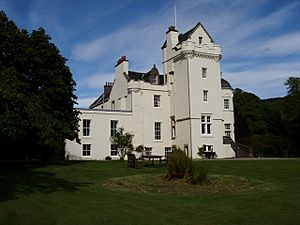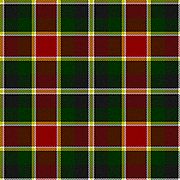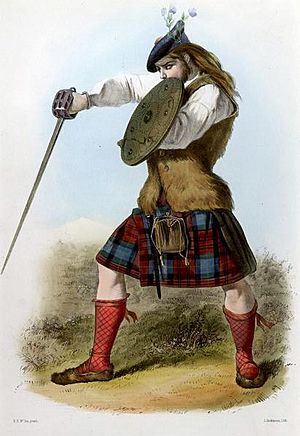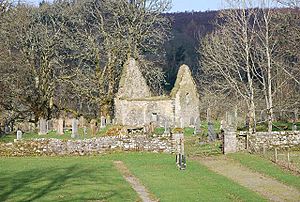Clan Maclachlan facts for kids
Quick facts for kids Clan Maclachlan |
|||
|---|---|---|---|
| Clann Lachlainn, Clann Lachainn | |||
 |
|||
| Motto | Fortis et Fidus (strong and faithful) | ||
| Profile | |||
| Region | Highlands | ||
| District | Loch Fyne, Argyll | ||
| Plant badge | Rowan (or mountain ash) | ||
| Pipe music | Moladh Màiri (In Praise of Mary) | ||
| Chief | |||
 |
|||
| Euan John Maclachlan of Maclachlan | |||
| 25th of Maclachlan and Baron of Strathlachlan | |||
| Seat | New Castle Lachlan | ||
| Historic seat | Old Castle Lachlan | ||
|
|||
|
|||
|
|||
Clan Maclachlan, also known as Clan Lachlan, is a Highland Scottish clan. It has its roots in the area of Strathlachlan on Loch Fyne, Argyll, on the west coast of Scotland. The clan believes its family line comes from Lachlan Mor. He lived by Loch Fyne in the 1200s. Many places in the area are named after him, like Strathlachlan and Castle Lachlan.
The clan also traces its history back to an Irish prince named Ánrothán Ua Néill. He was part of the O'Neill family and lived in the 1000s. Clan Maclachlan is connected to other clans like Clan Lamont and Clan Ewen of Otter. This is because they all believe they are descendants of Ánrothán O'Neill.
The Maclachlans were strong supporters of the Stuart kings of Scotland. They took part in the Jacobite risings, which were rebellions to bring the Stuart kings back to power. The clan's 17th chief was killed during the Battle of Culloden in 1746. After this battle, a government ship reportedly damaged the clan's old home, Castle Lachlan.
Today, Clan Maclachlan is still active through the Clan Maclachlan Society and the Lachlan Trust. The Lachlan Trust is a Scottish charity that raises money to protect the clan's history. The Clan Maclachlan Society has branches around the world. These include groups in Australia, Britain & Ireland, Canada, New Zealand, and the United States.
Contents
Clan History
How the Clan Started
Clan Maclachlan believes its story began with Lachlan Mor. He lived by Loch Fyne in the 1200s. His family originally came from Ireland to Scotland in the 1000s. The first person in this family was Anrothan, son of Aodh O'Neil, an Irish king. It's thought that Anrothan married a Scottish princess. This marriage helped his family gain control of lands in Knapdale and Cowal.
Several Scottish clans, like Clan MacNeil of Barra and Clan Lamont, also trace their family lines back to Anrothan. Lachlan Mor's mother was Elizabeth of the Clan Lamont. She was also a descendant of Somerled, a powerful Scottish lord.
Early Days of the Clan

Around 1230, a man named Gilchrist Maclachlan was a witness to an important document. This document was about lands in Kilfinan. In 1292, Gilleskel Maclauchlan received official papers for his lands in Argyll from King John of Scots. This is the first written proof of the clan owning land.
In 1296, Gillespie Maclachlan signed a document showing his loyalty to Edward I of England. This document was called the Ragman Rolls. Between 1306 and 1322, Gillespie received lands in Strathlachlan from Robert I of Scotland. He was also one of the Scottish leaders at the first Parliament of the king of Scots in 1309. Gillespie also signed a letter to the King of France in 1309. The French king had asked for help with a war, but the Scots said they were too busy fighting England.
Gillespie died by 1322. His brother Patrick took over as chief. Patrick's son, Lachlan, later became chief. In 1456, Lachlan's son, Donaldus Maclachlane, gave money to a church group in Glasgow. This money came from his lands near his home, Castle Lachlan.
There was a special tradition among the Maclachlan chiefs. It was said that the chief of Strathlachlan and the chief of Strachur (Clan Campbell) would attend each other's funerals. They would help lay their neighbor's head in the grave. This tradition might have started during the Crusades. It's believed the two family heads went to war together. They promised to bury each other if one of them died in battle.
From the Late 1400s Onwards
In 1487, Iain Maclachlan of Strathlachlan witnessed an agreement. Iain died around 1509. His son Gillescop married a daughter of Iain Lamont, the chief of Clan Lamont. Gillescop's son, Lachlan, later forced a Lamont family member off his land. For this, Lachlan was called before a special council. They decided that a Lamont heir had a stronger claim to the land.
Lachlan died between 1557 and 1559. His second son, Archibald, became chief. Archibald had only daughters. So, his nephew Lachlan Og became the next chief. Soon after, Lachlan Og had to give up some land to the Lamont chief. This was because of a murder committed by another Maclachlan. Lachlan Og also led the clan in a fight against Sir James Macdonald in 1615.
Lachlan Maclachlan was followed by his son Archibald. Archibald is known as the clan's 15th chief. In 1680, King Charles II of England made Archibald's lands into a special area called the Barony of Strathlachlan. This area was centered around Castle Lachlan. Even today, the clan chief is known as the Baron of Strathlachlan.
The Jacobite Risings
The Maclachlans were very loyal to the Jacobite cause. The Jacobites wanted to bring the Stuart kings back to the Scottish throne. The clan is thought to have been at the Battle of Killiecrankie in 1689. In 1715, Lachlan Maclachlan, the chief, signed a welcome letter to James VIII Stuart, the "Old Pretender."
Lachlan, the 17th chief, played a big part in the Jacobite Rising of 1745. He lost his life leading the clan at the Battle of Culloden. At that time, the Maclachlan fighting force was about 200 men. A letter from 1748 describes how Colonel MacLachlan led his men. He had 115 of his own clan members and 182 from Clan MacLean. He was shot by a cannonball while leading his regiment in battle.
After the Jacobite defeat, a government ship attacked Castle Lachlan. The chief's family had to leave their home. In Edinburgh, the Maclachlan battle flags were burned. People thought the chief's lands would be taken away because he supported the Jacobites. However, it was decided that he had died before he could be punished. The chief of the Campbells, the Archibald Campbell, 3rd Duke of Argyll, helped Donald, the son of the dead Maclachlan chief. He helped save the Maclachlan lands.
The Clan Today

In the early 1800s, a new Castle Lachlan was built for the clan chiefs. It is still the clan's main home today. The last male chief of Clan Maclachlan was John Maclachlan, who died in 1942. His daughter, Marjorie Maclachlan, became the 24th chief. She helped create the Clan Maclachlan Society in 1979. When she died in 1996, her eldest son, Euan John Maclachlan, became the 25th chief. He is also the Baron of Strathlachlan.
Today, the clan is active through the Clan Maclachlan Society and the Lachlan Trust. The Clan Maclachlan Society has eight groups around the world. These include Australia, Britain & Ireland, Canada, New Zealand, and the United States. The Lachlan Trust is a Scottish charity. It collects donations to protect the clan's history. The trust helped raise money to fix Kilmorie Chapel. This chapel is the traditional burial place for the chiefs. The work was finished in 2006. More money has been approved to protect the old castle and build a new bridge. Work started in 2013 to make the old castle site better for visitors. This includes new paths and information about the area's history.
Castle Lachlan
Old Castle Lachlan is a ruined castle on the east side of Loch Fyne. It dates back to the 1400s. The castle is about 70 feet (21 meters) long and 54 feet (16 meters) wide. Its highest point is about 43 feet (13 meters) tall.
In the late 1700s, Donald Maclachlan built New Castle Lachlan. This large house is about a ten-minute walk from the old ruined castle. The new house was first built in the Queen Anne style. Later, in the late 1800s, it was changed to the Scottish baronial style. The building is on a 1,500-acre (6.1 km²) estate. It has been divided in two. The chief lives in one part, and the other part can be rented out.
Clan Profile
Clan Chief
The current chief of Clan Maclachlan is Euan John Maclachlan of Maclachlan. He is the 25th chief and the Baron of Strathlachlan. The chief's home is the new Castle Lachlan.
Meaning of the Name
Clan Maclachlan gets its name from Lachlan Mor. The name Maclachlan comes from the Gaelic Mac Lachlainn. This means "son of Lachlan." The name Lochlann means "stranger." It was originally a word for Scandinavia. It combines loch (meaning "lake" or "fjord") and lann (meaning "land").
Clan Symbols
Members of Scottish clans wear crest badges to show they belong to a clan. These badges are usually worn on a hat. A crest badge has the chief's heraldic crest surrounded by a strap and buckle. It also has the chief's heraldic motto or slogan. The Maclachlan crest badge has the Latin motto FORTIS ET FIDUS. This means "strong and faithful." The crest itself shows a castle on a rock.
Another clan symbol is a clan badge or plant badge. These are special plants used to identify clan members. Clan Maclachlan has two plant badges: rowan (or mountain ash) and lesser periwinkle.
Many clans also have special pipe tunes. Clan Maclachlan's pipe music is Moladh Màiri. In Gaelic, this means "In Praise of Mary."
Tartans
| Tartan image | Notes |
|---|---|
 |
This is the most common Maclachlan tartan today. It is called the Standard or Modern tartan. It was first shown in a book in 1850. |
 |
This tartan was published in a book called the Vestiarium Scoticum in 1845. This book is now known to be a fake. However, it is the source of many of today's clan tartans. This one is known as the Dress tartan. |
 |
This is the Maclachlan hunting tartan. It was first published in 1893. It is also called Maclachlan hunting or Old MacLachlan. This pattern appeared in a collection from 1812. Even though it's one of the oldest, it hasn't been very popular with the clan. |
 |
This is an old Maclachlan tartan. It is also known as Small MacLachlan or Moncreiffe. This tartan was in a pattern book from 1790. Over time, it became linked to the Maclachlans. In 1974, the chief of Clan Moncreiffe asked the Maclachlan chief if his clan could use this tartan. The colors matched his family's Coat of Arms. Today, it is known as a Moncreiffe tartan. |
See also
- Claflin family
- Scottish clan
- Lochlann, the history of the word that the name Maclachlan comes from
- Harriet Maclachlan, a woman from the clan who was painted by a famous artist, Sir Henry Raeburn.



